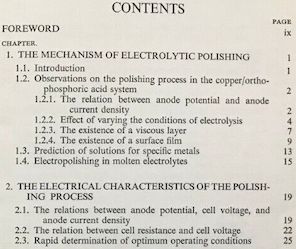
-----
Electropolishing vs. Passivation for stainless steel
Q. Is there a difference between Electropolishing and Passivation? If so which is better? Do you use citric acid in passivation and not in electropolishing?
Thanks,
Robert Hart- Abbott Part, Illinois, USA
2002
2002
and Chemical Polishing
of Metals in
Research and Industry"
by W.J. Tegart

on eBay or Amazon
or AbeBooks
(affil link)
A. Passivation is a non-electrolytic process which removes iron from the surface, rendering stainless steel more rust-proof. Electropolishing is an electrolytic process which dissolves the asperities to leave an ultra smooth surface for such reasons as cleanliness and to prevent materials from sticking. Both are traditionally done with very strong and concentrated acids.
It so happens that electropolishing is a very effective passivation method, though, traditionally rated as better than nitric acid passivation, so that if a part is electropolished it probably needs no supplemental passivation.
There are changes these days though, including citric acid passivation, and environmentally friendly electropolishing solutions.

Ted Mooney, P.E.
Striving to live Aloha
finishing.com - Pine Beach, New Jersey
Ted is available for instant help
or longer-term assistance.
A. There are many differences between electropolishing and passivation. Ted has alluded to some of these. Which method you use depends on your desired end result. If aesthetics (shiny surface) is important you need to electropolish, which also improves corrosion resistance dramatically because of the removal of the electrically active asperities, etc. There is a higher cost to electropolishing.
If just corrosion resistance is important, you can passivate with citric acid systems to get excellent results.
The Ultimate in corrosion resistance is attained by the combination of the two. Electropolishing followed by passivation with citric products on the market give you outstanding appearance AND corrosion resistance due to the VERY high chrome/nickel surface. Corrosion resistance is better than either one alone.

Lee Kremer
Stellar Solutions, Inc.
McHenry, Illinois

2002
Q. Are there different degrees of electropolishing?
Does that factor affect the need to passivate?
- Rocky Mount, North Carolina, USA
June 27, 2012
A. Hi, Matthew. Yes, there are probably different degrees of smoothness imparted by electropolishing (if you polish for an extended time you will obviously remove more metal than if you polish for a very short time), but I doubt that it effects the passivation situation. I think any electropolishing that imparts a satisfactory surface finish would impart satisfactory passivation.
Regards,

Ted Mooney, P.E.
Striving to live Aloha
finishing.com - Pine Beach, New Jersey
Ted is available for instant help
or longer-term assistance.
June 27, 2012
Q. Hello Everyone!
Recently I'm facing one problem with electropolishing of SS. We are using phosphoric acid with Elgrit chemical as the electrolyte provided by a private limited company. My problem is that liquid level in tank is increasing day by day. I'm not getting why this may be happen. Please suggest me your valuable feedback.
- Ahmedabad, Gujarat, India
August 7, 2013
A. It is probably absorbing moisture out of the air. If raising the tank temp is an option, it will gain less moisture. If not, decant and add concentrate is the other option.
James Watts- Navarre, Florida
August 8, 2013
A. Hi Umesh,
Without knowing the chemistry I would guess that your electro-polishing solution is hygroscopic and absorbing atmospheric moisture.
There isn't a great lot you can do, maybe keep a lid on your tank when not in use, probably keep your extraction running so as still air doesn't sit over the tank.
The important thing is to make sure your solution remains in specification so that you do not damage any parts during processing.
Aerospace - Yeovil, Somerset, UK
August 9, 2013
![]() Thank you very much for your valuable suggestions, Brian Terry and James Watts.
Thank you very much for your valuable suggestions, Brian Terry and James Watts.
- Ahmedabad, Gujarat, India
February 17, 2014
Q. Which specs approve electropolishing for CRES passivation?
Jerry Mandel- Dallas, Texas
October 25, 2015
A. Jerry,
ASTM A967 is a standard for passivation/corrosion resistance testing including electrochemical/electropolishing methods, ASTM B912 does the same specifically for electropolished stainless.

Ray Kremer
Stellar Solutions, Inc.
McHenry, Illinois

October 26, 2015
Q, A, or Comment on THIS thread -or- Start a NEW Thread
